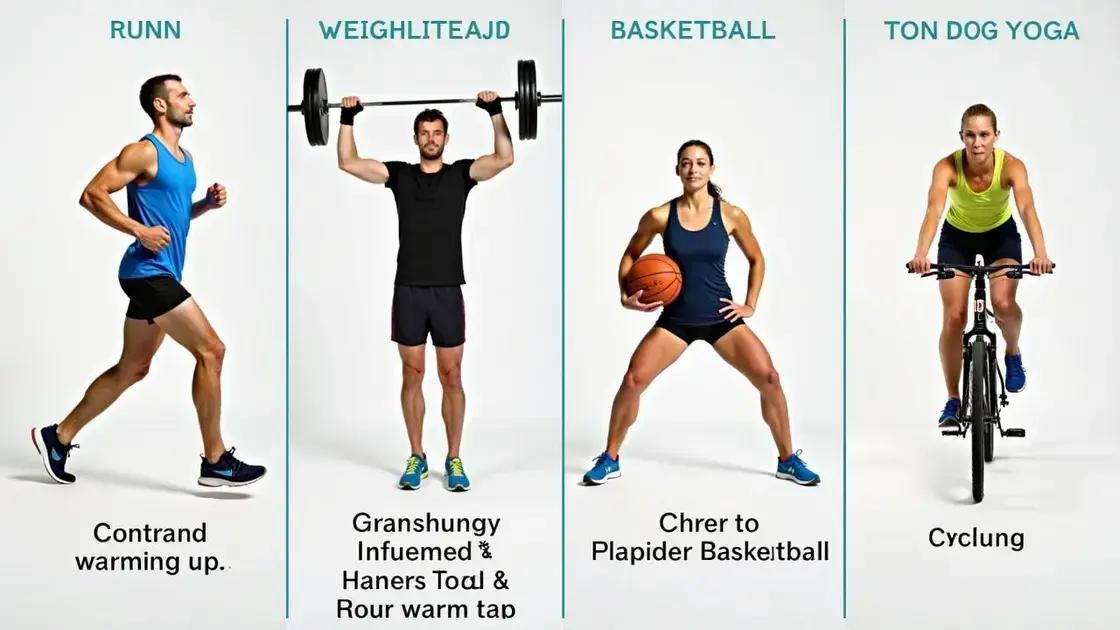Developing a consistent warm-up routine is essential for enhancing physical performance and preventing injuries. Key components include dynamic stretching, gradually increasing intensity, and customizing warm-ups for specific activities such as running, weightlifting, or team sports. To stick to your routine, set a schedule, vary your exercises, track progress, and consider workout partners. A well-tailored warm-up should last 10-15 minutes, ensuring your body is properly prepared for exercise.
Are you looking to enhance your performance in sports or workouts? Learning how to develop a consistent warm-up routine is essential for injury prevention and improved results. A well-crafted warm-up not only prepares your body physically but also mentally for the activities ahead. In this article, we will delve into the importance of warm-ups, key components of a successful routine, practical tips for consistency, and how to tailor your approach based on specific activities.
Understanding the Importance of Warm-Ups

Understanding the importance of warm-ups is crucial for anyone looking to improve their performance in physical activities. Warm-ups are not just a routine; they are a fundamental part of preparing your body for exercise. By gradually increasing your heart rate and blood flow to your muscles, you not only enhance your physical readiness but also reduce the risk of injury.
Warm-ups help to loosen up your joints and muscles, increasing flexibility and range of motion. This flexibility decreases the likelihood of strains and sprains during more intense activities. Additionally, warm-ups can improve your overall performance by enhancing muscle efficiency and coordination.
Physical Benefits of Warm-Ups
A proper warm-up raises your core body temperature, which can help reduce muscle stiffness and improve elasticity. This is particularly important for activities that require sudden bursts of intensity, such as sprinting or weightlifting.
Mental Preparation
Warm-ups are not just for the body; they also serve an essential role in mental preparation. Engaging in a warm-up routine allows you to focus your mind on upcoming tasks, fostering a mindset geared toward performance and concentration.
Reducing the Risk of Injury
When you skip warm-ups or do them improperly, you risk putting unnecessary strain on your body. An effective warm-up can help to prevent injuries by gradually preparing your body for more strenuous activity. This is particularly vital for athletes and those participating in high-impact sports.
In summary, understanding the importance of warm-ups is key to ensuring safety, improving performance, and preparing both your body and mind for the rigors of your activities.
Key Components of an Effective Routine

Creating an effective warm-up routine involves several key components that ensure your body is properly prepared for exercise. A successful warm-up should typically last between 10 to 15 minutes and should include activities that gradually increase in intensity.
Dynamic Stretching
Dynamic stretching is a vital element in any warm-up routine. This type of stretching involves moving your muscles through their full range of motion, which helps to improve flexibility and circulation. Common dynamic stretches include leg swings, arm circles, and walking lunges.
Gradual Intensity Increase
It’s essential to start your warm-up at a low intensity and gradually build up to levels that match your workout. This gradual increase prepares your heart and lungs for the upcoming effort and helps avoid shock to your system. For example, if you’re going to run, start with a brisk walk before transitioning to a light jog.
Specific Movements
Incorporating specific movements related to your planned activity can enhance the effectiveness of your warm-up. For instance, if you’re about to play basketball, include movements such as lateral shuffles and jump shots in your routine. This targeted approach enhances muscle memory and readies your body for the specific demands of your sport.
Incorporate Breathing Exercises
Breathing exercises can also be an integral part of your warm-up. Proper breathing techniques can help reduce anxiety and improve oxygen flow to your muscles. Try inhaling deeply through your nose and exhaling slowly through your mouth while performing light movements to calm your mind and body.
Tips for Sticking to Your Routine

Sticking to your warm-up routine can be challenging, but with a few practical tips, you can make it easier to stay consistent. Here are some effective strategies to help you maintain your warm-up routine.
Set a Specific Schedule
Establish a fixed time for your warm-ups, just like you schedule your workouts. Consistency is key, and having a dedicated time helps to form a habit. Make sure to choose a time that aligns well with your overall workout schedule.
Use a Variety of Warm-Up Exercises
Monotony can lead to boredom and a lack of motivation. Mix up your warm-up exercises to keep things interesting. Incorporate different dynamic stretches, mobility drills, and sport-specific movements. This variety can prevent your routine from becoming stale.
Track Your Progress
Keep a log of your warm-up sessions. Tracking your progress not only helps you stay accountable but also allows you to see improvements over time. You can use simple apps or a notebook to document the exercises you perform and how you feel afterward.
Find a Workout Buddy
Having a friend to warm up with can boost your motivation and make it more enjoyable. A workout buddy can help you stay accountable and encourage each other to keep up with the routine. Plus, it’s a great way to socialize while being active.
Reward Yourself
Set up a reward system to celebrate your consistency. Whether it’s treating yourself to a smoothie or enjoying a rest day, rewards can enhance your motivation. Recognizing your efforts will help reinforce the habit of warm-ups and encourage you to stick with them.
Customizing Your Warm-Up for Different Activities

Customizing your warm-up routine for different activities is essential for maximizing performance and preventing injury. Each sport or activity has unique demands, so tailoring your warm-up can help prepare your body effectively.
Running
If you plan to go for a run, focus on dynamic stretches that activate your leg muscles. Perform exercises like leg swings, high knees, and butt kicks to increase blood flow. Start with a brisk walk and gradually transition to a light jog to warm your muscles adequately.
Weightlifting
A warm-up for weightlifting should include mobility exercises targeting your joints and dynamic stretches for the muscle groups you will be using. Consider inchworms, bodyweight squats, and arm circles. These exercises will get your muscles ready and help prevent strains during heavier lifts.
Team Sports
For team sports like soccer or basketball, include sport-specific movements in your warm-up. Practice dribbling, passing, or sprinting drills that mimic game actions. Incorporate lateral movements and agility drills to prepare your body for quick changes in direction.
Yoga or Stretching Classes
If you are heading to a yoga class, your warm-up should focus on gentle stretches that increase flexibility. Practice deep breathing and slow movements to help relax your body and mind. Poses like cat-cow stretches or sun salutations can effectively prepare you for the session.
Cycling
When cycling, start with a gentle ride at a low intensity. Include upper body stretches to loosen your back and shoulders. Dynamic leg stretches, such as hamstring sweeps and hip openers, are crucial to get your legs ready for pedaling. This approach helps enhance your performance during the ride.
In Conclusion: Emphasizing the Importance of a Consistent Warm-Up Routine
Developing a consistent warm-up routine is essential for enhancing performance and reducing the risk of injury. Understanding the importance of warm-ups ensures that you prepare both your body and mind for your activities.
Key components of an effective routine, such as dynamic stretching and gradual intensity increases, play a crucial role in your warm-up. Additionally, sticking to your routine can be achieved through specific strategies, including setting a schedule and incorporating variety.
Customizing your warm-up for different activities allows for a more targeted approach, maximizing benefits specific to your sport or exercise. Whether you are running, lifting weights, or participating in team sports, a tailored warm-up can help optimize your performance.
Ultimately, combining all these aspects into a cohesive warm-up routine will set you up for success in achieving your fitness and performance goals.
FAQ – Frequently Asked Questions about Developing a Consistent Warm-Up Routine
Why is warming up important before exercise?
Warming up is crucial for increasing blood flow to your muscles, improving flexibility, and reducing the risk of injuries during workouts.
What are the key components of an effective warm-up routine?
Key components include dynamic stretching, gradually increasing intensity, and incorporating movements specific to the activity you will perform.
How can I stick to my warm-up routine?
To stick to your routine, set a specific schedule, use a variety of warm-up exercises, track your progress, find a workout buddy, and reward yourself for consistency.
How should I customize my warm-up for different activities?
Customize your warm-up by including dynamic stretches and specific movements related to the activity, such as sprinting drills for running or mobility exercises for weightlifting.
How long should my warm-up last?
A good warm-up should typically last between 10 to 15 minutes, allowing enough time to prepare your body for exercise.
Can I skip warming up if I’m short on time?
Skipping warm-ups is not advisable, as it increases the risk of injury. If you’re short on time, even a brief warm-up is better than none.













